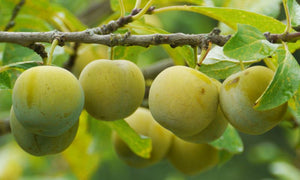OPAL european plum tree DWARF (Krysmk 1)
Shipping calculated at checkout
15 in stock
Need more? Contact us
This tree needs pollination
Compatible trees:
Plum tree GREEN GAGE semi-dwarf (Marianna 26-24) and DWARF
Plum tree GREEN GAGE semi-dwarf (Marianna 26-24) and DWARF
Available only in spring 2026
🍑 Opal plum tree (Prunus domestica ‘Opal’)
🌸 Origin and type
- Species: Prunus domestica
- Origin: Sweden, 1925
- Breeder: Alnarp Research Institute
- Type: Self-fertile European plum tree
🌳 Tree characteristics
- Habit: Spread out, well branched
- Mature height: Approximately 5 m
-
Hardiness:
USDA Zone 5–6 (resistant to temperatures as low as –15°C) - Exposure: Sun or partial shade, sheltered from the wind
- Soil: Rich, deep, well-drained, slightly calcareous accepted
- Growth: Average, fast fruiting (often after 2–3 years)
🍑 Fruit
- Shape: Round to oval
- Size: Medium (35–45 mm)
- Skin: Purple-red on a yellow background, sometimes with a bluish bloom
- Flesh: Golden yellow, firm, juicy
- Flavor: Sweet, fragrant, slightly tart
- Stone: Semi-adherent
- Harvest: Late July to early August
- Use: Fresh, jams, pastries, compotes
- Storage: 2–3 weeks in a cool place
🌼 Flowering and pollination
- Flowering: Mid-March to April (moderately early)
- Self-fertile: Yes ✅
- Recommended pollinators: Reine-Claude d'Oullins, Mirabelle de Nancy (improve yield)
🛠️ Cultivation and care
- Planting: Fall or early spring
- Watering: Regularly for the first few years, then moderately
- Pruning: Winter, to aerate the branches and promote light
- Thinning: Recommended if the tree bears a lot of fruit
- Diseases: Good resistance to common diseases
🍽️ Uses
- Fresh fruit at the table
- Jams, compotes, pastries
- Less suitable for drying or freezing
💡 Advantages
✅ Self-fertile, ideal for small gardens
✅ Early harvest (end of July)
✅ Excellent taste
✅ Good disease resistance
⚠️ Points to watch
- Flowering sensitive to spring frosts
- Fruits are fragile, require careful harvesting
- Prefer a sheltered location to avoid wind damage



